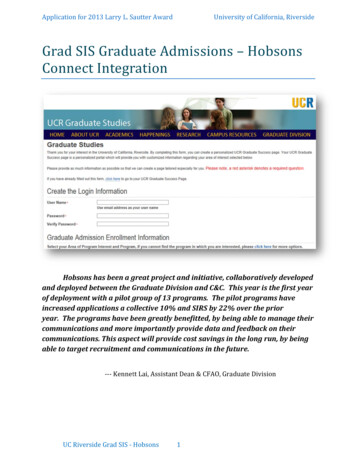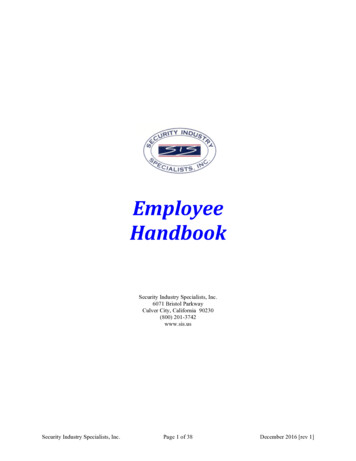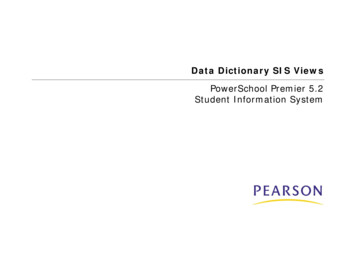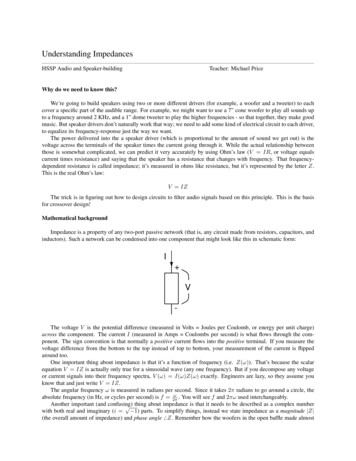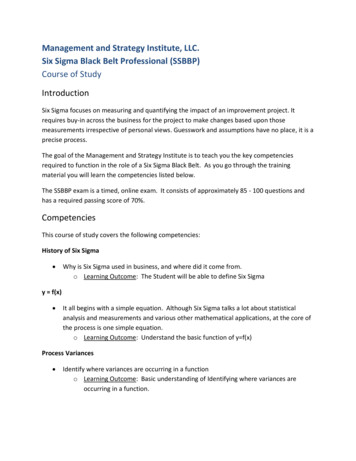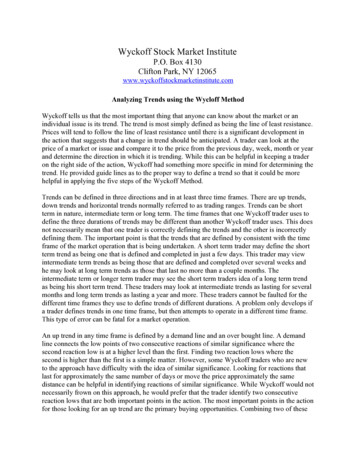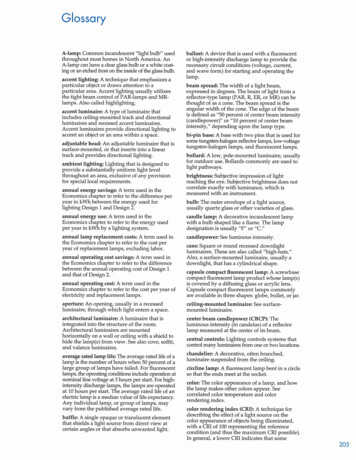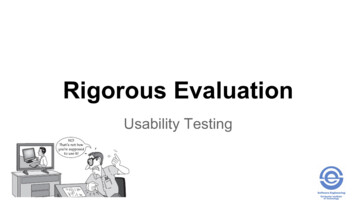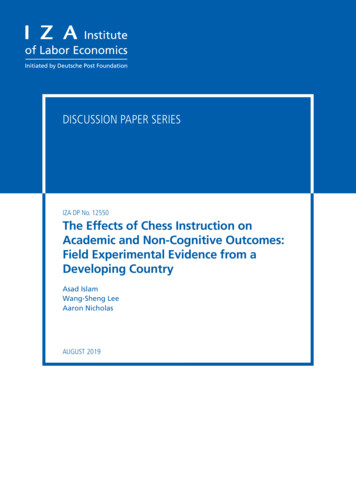
Transcription
DISCUSSION PAPER SERIESIZA DP No. 12550The Effects of Chess Instruction onAcademic and Non-Cognitive Outcomes:Field Experimental Evidence from aDeveloping CountryAsad IslamWang-Sheng LeeAaron NicholasAUGUST 2019
DISCUSSION PAPER SERIESIZA DP No. 12550The Effects of Chess Instruction onAcademic and Non-Cognitive Outcomes:Field Experimental Evidence from aDeveloping CountryAsad IslamMonash UniversityWang-Sheng LeeDeakin University and IZAAaron NicholasDeakin UniversityAUGUST 2019Any opinions expressed in this paper are those of the author(s) and not those of IZA. Research published in this series mayinclude views on policy, but IZA takes no institutional policy positions. The IZA research network is committed to the IZAGuiding Principles of Research Integrity.The IZA Institute of Labor Economics is an independent economic research institute that conducts research in labor economicsand offers evidence-based policy advice on labor market issues. Supported by the Deutsche Post Foundation, IZA runs theworld’s largest network of economists, whose research aims to provide answers to the global labor market challenges of ourtime. Our key objective is to build bridges between academic research, policymakers and society.IZA Discussion Papers often represent preliminary work and are circulated to encourage discussion. Citation of such a papershould account for its provisional character. A revised version may be available directly from the author.ISSN: 2365-9793IZA – Institute of Labor EconomicsSchaumburg-Lippe-Straße 5–953113 Bonn, GermanyPhone: 49-228-3894-0Email: publications@iza.orgwww.iza.org
IZA DP No. 12550AUGUST 2019ABSTRACTThe Effects of Chess Instruction onAcademic and Non-Cognitive Outcomes:Field Experimental Evidence from aDeveloping Country*We conduct a randomized field experiment to investigate the benefits of an intensivechess training program undertaken by primary school students in a developing countrycontext. We examine the effects on academic outcomes, and a number of non-cognitiveoutcomes: risk preferences, patience, creativity and attention/focus. Our main finding isthat chess training reduces the level of risk aversion almost a year after the interventionended. We also find that chess training improves math scores, reduces the incidence oftime inconsistency and the incidence of non-monotonic time preferences. However, these(non-risk preference) results are less conclu-sive once we account for multiple hypothesistesting. We do not find any evidence of significant effects of chess training on otheracademic outcomes, creativity, and attention/focus.JEL Classification:C93, D80, I21Keywords:chess training, math, non-cognitive outcomes, risk, randomizedexperimentCorresponding author:Asad IslamDepartment of EconomicsMonash UniversityPO Box 197Caulfield EastVictoria 3145AustraliaE-mail: Asadul.Islam@monash.edu* We thank participants at the Labour Econometrics Workshop 2017 in Auckland, the 2017 Asian and AustralasianSociety of Labour Economics (AASLE) conference in Canberra, the 17th IZA-SOLE Transatlantic Meeting of LaborEconomists (2018) in Buch/Ammersee, and workshops at Deakin University, Monash University and SingaporeManagement University for their comments. Foez Mojumder provided excellent research support. This research wouldalso have not been possible without cooperation from the Department of Primary Education (DPE) in Bangladesh,local school teachers, NGO partner Global Development Research Initiative (GDRI) and our chess coaches. We aregrateful to Deakin University and Monash University for their generous research funding.
1. IntroductionChess as an education tool is becoming increasingly common in many countries. Itspopularity is at least in part attributable to its perceived effect on cognitive skills in general,and math ability in particular. In recent years, chess coaching for children has becomeincreasingly popular in developed countries. 1 The European Parliament has expressed afavorable opinion on using chess courses in schools as an educational tool (Binev et al., 2011).In 2014, School Library Journal's best education pick of the year was a chess-related productcalled Yamie Chess, which is backed by Harvard and MIT academics. 2 The benefits of playingchess regularly have been suggested in a documentary that focuses on an inner-city school inNew York, and two European countries – Armenia and Poland – have even made chessinstruction compulsory in their primary-school curricula. 3 More recently, the city of Bremenin Germany has decided to introduce one hour of chess per week as a subject in primary schoolsin 2020, an issue covered widely in the German press. 4Parents and teachers generally view chess as a highly regarded extracurricular activityin primary school. However, to date, there is hardly any study rigorously examining the effectsof chess instruction. An exception is Jerrim et al. (2018), who report results from a randomizedcontrolled trial (RCT) conducted in the UK to evaluate the impact of teaching children chesson academic outcomes. Contrary to popular belief, they found no evidence that teachingchildren chess improved their math ability. There were also no impacts on reading and science.In this paper, we conduct an RCT to examine the effects of intensive chess lessonsamong grade five students in a developing country. We follow the curriculum approved by theWorld Chess Federation. We differ from Jerrim et al. (2018) and the literature on the impactof chess training on two counts. First, we study the link between chess and non-cognitiveoutcomes such as risk preferences, patience, creativity, attention and focus. Second, weexamine the effects of chess learning in a developing country context. Children in ourFor example, in the US, the Chess Club and Scholastic Center of St. Louis (a 6,000-square-foot, state-of-the-artchess center widely recognized as the premier chess facility in the country and one of the best in the world) helpsprovide chess-coaching services to many elementary and middle schools in St. Louis, Missouri. For the list ofschools, see: -education (accessed March 27, 2017).2Yamie Chess features an interactive coloring math comic book written by experienced math teachers for K-8supplemental math learning.3The documentary film Brooklyn Castle (2012) highlights the after-school chess program in an inner-city publicschool in Brooklyn, New York and how they became the first middle-school team to win the U.S. ChessFederation's national high school championship. For compulsory chess instruction in Armenia, armenia-chess-compulsory-schools (accessed March 27, 2017).For Poland, see: -in-all-schools (accessed March 27, 2017).4See holastic-tournament-in-bremen-2019 (accessed 2 July,2019).11
experiment come from rural primary schools in Bangladesh who do not have previousexperience playing chess. Our setting is particularly well-suited to test the benefits of a chesstraining program because unlike children in urban areas in a developed country, most childrenin rural areas in a developing country will never have been exposed to the game of chess before,much less any other cognitively demanding games. 5We first examine the effects of chess training on test scores. Our primary outcomes fortest scores come from a standardized, compulsory public exam that all fifth-grade students inBangladesh must take – the Primary School Certificate (PSC) exam – which took place 9-10months after the completion of chess training. While we are particularly interested inexamining the effects on math test scores because of the perceived math benefits from playingchess, we also examine the results for students’ first language and science. 6Chess is often regarded as a game reflecting real life and teaching children how to playchess in a prescribed systematic fashion might also help in their development of important noncognitive outcomes. Therefore, we pay particular attention to the collection of extensive dataon non-cognitive outcomes to examine the effects of chess training. In particular, we measurerisk preferences, patience, creativity and attention/focus.Chess, through the formation of strategies, can be useful for the conceptualization andcalculation of risks. 7 For example, chess players often sacrifice pawns, bishops, knights, rooks,or queens if it helps checkmate the opponent’s king and win the game. Such sacrifices areinherently risky because if one’s calculations are faulty, the sacrifice could prove to be fatal,eventually leading to a quick loss of the game. Gambits and sacrifices can be made during anyof the three phases of a chess game – opening, middlegame, or endgame. Such an associationbetween risk taking and chess playing is, for example, utilized to study the link between riskpreferences and attractiveness (Dreber et al., 2013) through behaviour in chess. 8 Thus, learningJerrim et al. (2016, p. 46) report in their study that chess playing activity at their baseline was 48% in treatmentschools and 45% in control schools. Such levels are not surprising given that their study was based in an urbandeveloped country setting.6Studies in the education literature (e.g., Scholz et al. 2008; Trinchero and Sala 2016) also suggest that chessimproves children's math skills because the game has some elements in common with the mathematical domainand because it promotes suitable habits of mind.7Risk aversion is a trait typically associated with welfare-relevant, later life outcomes. Hence, its detection (andpotential manipulation) from an early age may be of particular policy interest. Davis and Eppler-Wolff (2009)argue that parents need to understand the significance of risk-taking as a teaching experience for children. Higherrisk aversion has been shown to be detrimental to key household decisions, such as choice of occupation, portfolioselection and moving decisions (Guiso and Paiella, 2008). On the other hand, higher risk aversion has also beenlinked to less disciplinary referrals and a higher probability of high school completion (Castillo, Jordan and Petrie,2018).8There, risk taking in chess is measured by exploiting a standardized classification of opening moves and expertassessments. As chess players in our setting are beginners who are unlikely to have a well thought out opening52
how to play chess and gaining an appreciation of basic chess strategy can help in thedevelopment and articulation of risk preferences in children. Of course, being able to calculateand appreciate risks may either increase or decrease risk aversion: the risk hypothesis we testis therefore two-sided. In addition, chess playing may decrease risk aversion through increasedexposure to competition. Experimental studies by Eriksen and Kvaløy (2017) and Spadoni andPotters (2018), for example, provide evidence that an increase in competitive pressuredecreases risk aversion.Furthermore, chess might help teach children to be more patient, more focused, andhave more self-control. 9 It can potentially motivate children to become willing problem-solvers,able to spend hours quietly immersed in logical thinking. Chess can also be a useful tool toteach the importance of forward-looking behavior. An important element in chess is theevaluation process, i.e., one needs to look a few steps ahead during a chess game and considerand evaluate alternative scenarios. Chess can teach children how to focus and visualize byimagining a sequence of events before it happens. The schematic thinking approach in chessresembles trees and branches in sequential-decision analysis and might also be useful andpossibly transferable to math skills, as has been emphasized previously (Scholz et al., 2008;Trinchero and Sala, 2016).In addition to children’s risk preferences and time preferences, we also investigatewhether undertaking intensive chess lessons can affect children’s creativity and attention/focus.Although there is some debate over whether creativity is an aspect of intelligence or apersonality trait, several studies have shown that creativity can be experimentally manipulated(see Runco and Sakamoto, 1999, for a review). The ability to focus on a task at hand is also auseful non-cognitive outcome that chess might be able to nurture. Attention is considered to bea major part of working memory, responsible for the control of flow of information, switchingbetween tasks and selection of relevant stimuli and inhibition of irrelevant ones (Travis, 1998).The study of the development of attention occupies a central place in cognitive developmentalpsychology, and we use frequently used tests for focus/attention in our evaluation.repertoire (a regular set of openings they use to start the game), it is not possible to adopt such an approach tomeasure risk preferences.9Becker and Mulligan (1997) suggest that observed differences in time preferences are not innate and that theevolution of these preferences may be endogenous. This implies that children could be taught to be more forwardthinking. If patience and other time preference-related characteristics of children vary across gender ordemographic groups, different educational paths and career outcomes may occur. For example, Castillo et al.(2011) find that boys are more impatient than girls, and that impatience has a direct correlation with disciplinaryreferrals – behavior that has been shown to be predictive of economic success.3
This paper is relevant to several sub-fields of economics. First, there has been muchrecent interest in the development of non-cognitive skills in children and their importance inlater life outcomes in the economics literature. Non-cognitive skills have been shown to bevery important for a host of outcomes, including schooling, social behaviors, drugs, smoking,truancy, teenage
chess training program undertaken by primary school students in a developing country context. We examine the effects on academic outcomes, and a number of non-cognitive outcomes: risk preferences, patience, creativity and attention/focus. Our main finding is that chess training reduces the level of risk aversion almost a year after the intervention ended. We also find that chess training .
